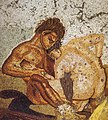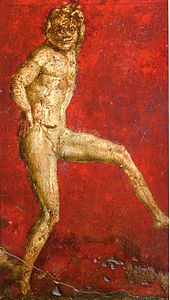Satyr
![]()
The title of this article is ambiguous. For other meanings, see Satyr (disambiguation).
A satyr (Ancient Greek Σάτυρος Sátyros, plural Σάτυροι Sátyroi, Latin Satur, Saturus) or silen (Σιληνός, Σειληνός Silēnós, Seilēnós, Plural Σιληνοί, Σειληνοί Silēnói, Seilēnói, Doric Σιλανός Silanós, Latin Silenus, Silanus) is a demon in the retinue of Dionysus in Greek mythology. Satyrs are among the hybrid beings of Greek mythology. They appear relatively late, at the end of the 7th century BC; as a single figure, Silenos in particular stands out. A distinction is made between the Silene (Silenoi, older satyrs with fat bellies and bald heads) and Satyrisci (Satyriskoi, youthful and childlike satyrs), although it is often not possible to make a clear distinction in pictorial representations. They are identified with the fauns by Roman poets.

Satyr with aulos. Epictetus, 520-500 BC.

Maenad and Satyr with Thyrsos. Penthesilea painter, ca. 460 BC.

Dionysus with his entourage on a comos. Euxitheos and Euphronios, 510-500 B.C.
Myth
Nothing exact is known about the origin of the Satyrs; according to Hesiod they are said to be descended from five daughters of Hekateros. They represented the male principle in relation to the nymphs. As similar nature spirits, they bore attributes of the "all-god" Pan as well as some of Priapus. Their name meant "the full ones" in a dialect of the ancient Peloponnese, referring both to their physique and to their erotically aroused state.
The Satyrs and Silene are said to have fought as Dionysus' troops in the Gigantomachy, terrifying the giants with the braying of their asses.
Otherwise, little is found in Greek mythology about the satyrs as a whole, very little compared to their presence in art, especially in vase painting. Some is found in relation to individual satyrs, so in the Dionysiaka, the great epic of Nonnos of Panopolis about the myths surrounding Dionysus, especially his campaign to India, several satyrs are mentioned with names, but these remain largely contourless and their names are mostly derived from epithets of Dionysus.
Satyrs, with whom are associated their own myths:
- Ampelos, lover of Dionysus, was killed by a bull and turned into a vine by Dionysus;
- Krotos, inventor of the bow and clock generator in the singing of the Muses, was placed in the sky as the constellation Sagittarius;
- Marsyas, who lost a musical contest with Apollo, was flayed alive by the god in return.
- Silenos, leader of the chorus of satyrs and silenes in the satyr play, tutor of Dionysus.
View
Usually the satyrs or silene are depicted snub-nosed, bald-headed, unclothed and ithyphallic. As hybrid beings they are usually equipped with ears and tails of horses or donkeys, often also with animal extremities. Their pictorial representation begins in the 6th century BC in the vase paintings of Attica, Crete and Thasos; from the temple of Apollo at Thermos comes a gargoyle in the form of a head from this period. As the retinue of Dionysus, they are often depicted with the Maenads, who also belong to the Dionysian retinue.
In representations of the Archaic period they are endowed with horse or donkey features and are depicted only in connection with a few mythological motifs; with the development of the satyr play they then increasingly appear in other contexts. Also under the influence of the satyr play, they are increasingly humanized as inventors of viticulture and music and thus as bringers of culture, but they always remain animalistic enough to be able to represent a counter-image to the values of the polis bourgeois or to serve the mythical exaltation of Symposion and Komos. Their typical attributes are added to them early on. The Askos, already found on the François vase, associates them with wine, both cultivation and enjoyment, the Aulos with music and dance. In Attic representations they are usually snub-nosed participants in a como, equipped with human feet, or they lustfully approach the maenads, although sexual acts rarely occur.
They received their buck characteristics only in Hellenism, probably under the influence of representations of the Panes and the Paniskoi, who appeared in the same role as the Satyrs. They appear sometimes with the goblet, sometimes in a bacchanalian frenzy with the thyrsos, sometimes devoted to sleep, sometimes drinking wine, also playing the flute or beating the cymbal, often united with the nymphs in rapid dances or lustfully pursuing them.
Praxiteles is considered the creator of the sculpture resting satyr.
· 
Dancing Silen
· 
Mosaic from the House of the Faun, Pompeii
· 
Youthful satyr with flute, Louvre
· _-_Nymphs_and_Satyr_(1873).jpg)
Nymphs and Satyr, William AdolpheBouguereau, 1873
· _-_n._1140_-_1898_-_Gallo_p._16.jpg)
Sicilian Boy as Faun, Wilhelm von Gloeden, 1898

Satyr (fresco from the Villa dei Misteri, Pompeii)
Search within the encyclopedia